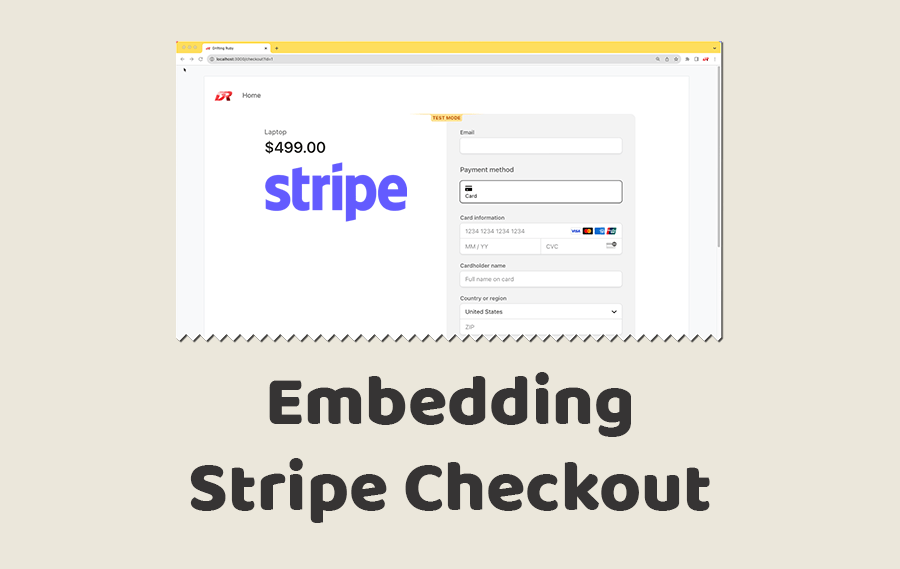
Summary
Stripe Checkout is one of my favorite ways to handle payments in Ruby on Rails applications. Stripe Checkouts will soon have an option to embed the Checkout into your web application. In this episode, we'll look at implementing this feature with a StimulusJS controller.rails stripe stimulusjs hotwire 19:11
Chapters
- Introduction (0:00)
- Setting up the application (2:05)
- Setting up Stripe (5:27)
- Creating the Stripe Checkout Session (7:36)
- Creating the stimulus controller (11:20)
- Testing the Stripe Checkout (15:14)
- Verifying the purchase (15:49)
- Final thoughts (18:20)
Resources
Stripe Documentation - https://stripe.com/docs/payments/accept-a-payment?platform=web&ui=embedded-checkout
Github Repo - https://github.com/driftingruby/422-embedding-stripe-checkout
This episode is sponsored by Honeybadger
Github Repo - https://github.com/driftingruby/422-embedding-stripe-checkout
This episode is sponsored by Honeybadger
Summary
# Terminal
rails g scaffold product name 'price:decimal{8,2}'
rails g model order session_id stripe_checkout_id status:integer
rails g controller checkouts
rails g controller payments
bundle add stripe
bin/rails credentials:edit
rails g stimulus stripe# credentials stripe: publishable_key: pk_test_XXX secret_key: sk_test_XXX
# db/migrate/20231001004208_create_orders.rb
class CreateOrders < ActiveRecord::Migration[7.1]
def change
create_table :orders do |t|
t.string :session_id
t.string :stripe_checkout_id
t.integer :status, default: 0
t.timestamps
end
end
end# app/models/order.rb
class Order < ApplicationRecord
enum status: {
pending: 0,
paid: 1
}
end# config/routes.rb resources :products resource :checkout, only: :show resource :payments, only: :show
# app/views/products/index.html.erb <td><%= link_to "Purchase", checkout_path(id: product) %></td>
# config/initializers/stripe.rb Stripe.api_key = Rails.application.credentials.dig(:stripe, :secret_key) Stripe.api_version = "2023-08-16;embedded_checkout_beta=v2"
# app/views/layouts/application.html.erb <%= javascript_include_tag "https://js.stripe.com/v3/", "data-turbo-track": "reload" %>
# app/controllers/checkouts_controller.rb
class CheckoutsController < ApplicationController
def show
@session = Stripe::Checkout::Session.create(
line_items: [{
price_data: {
currency: "usd",
product_data: {
name: product.name
},
unit_amount: (product.price * 100).to_i
},
quantity: 1
}],
mode: "payment",
ui_mode: "embedded",
return_url: CGI.unescape(payments_url(session_id: '{CHECKOUT_SESSION_ID}'))
)
Order.create(session_id: session.id, stripe_checkout_id: @session.id)
# current_user.orders.create(stripe_checkout_id: @session.id)
end
private
def product
@product ||= Product.find(params[:id])
end
end# app/views/checkouts/show.html.erb <div data-controller="stripe" data-stripe-public-key-value="<%= Rails.application.credentials.dig(:stripe, :publishable_key) %>" data-stripe-client-secret-value="<%= @session.client_secret %>"> </div>
# app/javascript/controllers/stripe_controller.js
import { Controller } from "@hotwired/stimulus"
// Connects to data-controller="stripe"
export default class extends Controller {
static values = { publicKey: String, clientSecret: String }
stripe = Stripe(this.publicKeyValue, { betas: ["embedded_checkout_beta_1"] })
async connect() {
this.checkout = await this.stripe.initEmbeddedCheckout({
clientSecret: this.clientSecretValue
})
this.checkout.mount(this.element)
}
disconnect() {
this.checkout.destroy()
}
}# app/controllers/payments_controller.rb
class PaymentsController < ApplicationController
def show
@order = Order.find_by(
session_id: session.id.to_s,
stripe_checkout_id: params[:session_id]
)
stripe_session = Stripe::Checkout::Session.retrieve(params[:session_id])
if stripe_session.status == "complete"
@order.paid!
# Other business logic
# elsif stripe_session.status == "open"
else
@order.pending!
end
end
end# app/views/payments/show.html.erb <h1>Successful Payment</h1> <%= @order.inspect %>